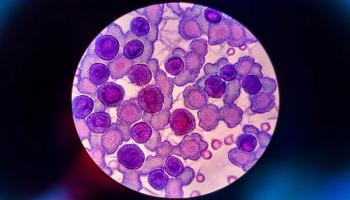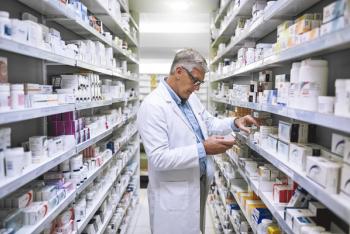
- May 2017 Skin & Eye Health
- Volume 83
- Issue 5
Dry Eye Disease: Higher Rates in View
Dry eye is a common condition, occurring when tears do not provide adequate lubrication for the eyes.
Dry eye syndrome, also known as “dry eye” and “dry eye disease,” is the condition of having dry eyes.1 Dry eye is a common condition, occurring when tears do not provide adequate lubrication for the eyes.2 It is a multifactorial syndrome of the ocular surface and tears, resulting in discomfort, visual disturbances, altered tear film stability, and possible damage to the ocular surface.3 Other names for dry eye specify the underlying cause, such as keratitis sicca (dryness and inflammation of the cornea), keratoconjunctivitis sicca (dryness affecting the cornea and the conjunctiva), and dysfunctional tear syndrome (inadequate quantity and/or quality of tears).1
A normal tear film consists of 3 components, each serving a critical purpose.1 One, the lipid component is produced by the Meibomian glands and is responsible for keeping the tear film from evaporating too quickly.1 Two, the aqueous component is produced by the lacrimal glands.1 Three, the mucin component is produced by the goblet cells and helps anchor and spread the tears across the eye’s surface.1
A 2012 Gallup poll estimated that 26 million Americans suffer from dry eye, and this number is projected to increase by 3 million by 2022.1 Other sources suggest that 48% of adult Americans regularly experience dry eye symptoms and that 5 million Americans 50 years and older suffer from significant dry eye sypmtoms.1 Dry eye syndrome is nearly twice as common in women as in men.1
CAUSES
Dry eye can develop for many reasons and to varying degrees. Although dry eye can occur at any age, it becomes increasingly more common over the age of 50. Most elderly patients experience some form of dry eye symptoms.4
Certain medical conditions can contribute to dry eye, including lupus, rheumatoid arthritis, diabetes, thyroid disease, and Sjögren’s syndrome.1,4
Dry eye can be associated with various medications, including antihistamines, decongestants, blood pressure medications, antidepressants, and birth control pills.1,4
Environmental factors, such as smoke, wind, and dry climates, can increase evaporation of tears. Not blinking often, such as while watching television or using digital devices, can increase the incidence and symptoms of dry eye.1,4
Women can develop dry eye due to hormonal changes during pregnancy, menopause, or the use of oral contraceptives.1,4
Dry eye discomfort is the primary reason individuals stop wearing contacts, although the extent to which contact lenses contribute to dry eye is unclear.1
Refractive eye surgery (LASIK) can decreasetear production and lead to dry eye.4 Other factors contributing to dry eye can include frequent flying, decreased humidity, and eyelid problems such as incomplete closure of the eyes during sleep or blinking.1
SYMPTOMS
Symptoms of dry eye often include ocular irritation, dryness, grittiness, burning, itching, redness, sensation of a foreign body, hyperemia, mucoid discharge, excessive tearing, photophobia, and fluctuating or blurry vision.3,6
DIAGNOSIS
Dry eye can be diagnosed through a comprehensive eye exam or tests to evaluate the quantity and quality of tear production.
An eye exam consists of a patient history to determine symptoms, medications, general health problems, and environmental factors that may contribute to dry eye. An external evaluation of the eye, lid structures, and blink aspects is also important. A lighted magnification examination of the cornea and eyelids to check for scarring or abnormalities can also help.4
Tests can include a visual acuity measurement, a slit lamp exam, diagnostic staining of the cornea and tear film, measurement of tear film breakup time, measurement of rate of tear production (Schirmer’s test), and measurement of concentration of tears (osmolality).6
TREATMENT
Frequent use of lubricating drops, such as artificial tears, may be the best treatment for mild cases of dry eye from situational causes such as computer use or reading. The challenge facing patients looking for relief of mild dry eye is choosing from among the overwhelming number of brands and formulations.7
Lubricating eyedrops with a low viscosity provide short-term relief from dry eye and do not cause much blurred vision. Although drops with a high viscosity can provide longer-lasting relief, they may cause blurry vision for several minutes.7 Ingredients that relieve aqueous deficiency dry eye may not work as well on evaporative dry eye, and vice versa. Therefore, if patients are given a recommendation from their primary care provider, they should not use a different lubricating drop.7
Cyclosporine (Restasis by Allergan) is a prescription eyedrop that acts as an immunomodulator with anti-inflammatory effects and helps the body produce more natural tears to keep eyes moist, comfortable, and healthy. Cyclosporine does not work immediately the way lubricating drops do. Patients should be advised that they must use cyclosporine drops for a full 90 days to experience the full benefits. Cyclosporine may also burn the eye at the time of application for the first few weeks.7
Lifitegrast (Xiidra by Shire), also an immunomodulator, is the first in a new class known as “lymphocyte function-associated antigen-1 antagonists” for treating chronic dry eye.8 According to phase 3 trial results, patients experienced relief of symptoms as early as 14 days after starting therapy, and the drug is very well tolerated.8
Steroid eyedrops are often used for a short time to decrease inflammation quickly. They can also be used in conjunction with cyclosporine and lubricating drops.7
In addition, many in-office procedures can help with dry eye syndrome. Examples include slow-release lubrication inserts, punctal plugs, Meibomian gland expression, and intense pulse light treatments.7
Patients should be educated about home remedies for reducing symptoms of dry eye. Warm compresses can be used to help open clogged Meibomian glands. Frequent blinking and breaks from screen time can also help reduce symptoms. Patients should wear good-quality sunglasses and keep their eyelids clean.
Other considerations include medication adjustment and decreasing or discontinuing the use of contact lenses.
Dr. Kenny earned her doctoral degree from the University of Colorado Health Sciences Center. She has more than 20 years of experience as a community pharmacist and works as a clinical medical writer based out of Colorado Springs, Colorado. Dr. Kenny is also the Colorado Education Director for the Rocky Mountain Chapter of the American Medical Writers Association and a regular contributor to Pharmacy Times®.
REFERENCES
- Understanding dry eye syndrome. All About Vision website. allaboutvision.com/conditions/dryeye-syndrome.htm. Updated December 2016. Accessed February 2, 2017.
- Dry eyes. Mayo Clinic website. mayoclinic.org/diseases-conditions/dry-eyes/basics/definition/con-20024129. Published July 24, 2015. Accessed February 4, 2017.
- Dry eye syndrome. MedScape website. http://emedicine.medscape.com/article/1210417-overview. Updated July 14, 2016. Accessed February 4, 2017.
- Dry eye. American Optometric Association website. aoa.org/patients-and-public/eye-and-vision-problems/glossary-of-eye-and-vision-conditions/dry-eye. Accessed February 4, 2017.
- Facts about dry eye. National Eye Institute website. https://nei.nih.gov/health/dryeye/dryeye. Updated February 2013. Accessed February 4, 2017.
- Dry eye syndrome. Medline Plus website. https://medlineplus.gov/ency/article/000426.htm. Accessed February 4, 2017.
- Dry eye treatment: getting relief from dry eyes. All About Vision website. allaboutvision.com/conditions/dryeye.htm. Updated November 5, 2014. Accessed February 4, 2017.
- Holland EJ, Luchs J, Karpecki PM, et al. Lifitegrast for the treatment of dry eye disease: results of a phase III, randomized, double-masked, placebo-controlled trial (OPUS-3). Am Acad Ophthamol. 2017;124(1):53-60. doi: 10.1016/j.ophtha.2016.09.025.
Articles in this issue
over 8 years ago
Pet Peeves (May 2017)over 8 years ago
Can You Read These Rxs? (May 2017)over 8 years ago
Case Studies (May 2017)over 8 years ago
Generic Product News (May 2017)over 8 years ago
FDA Report Recaps Progress, Goals in Generic Drug Approvalsover 8 years ago
Children Face Greatest Risk of Sport-Related Eye Injuriesover 8 years ago
LASIK Poses Lower Risk of Infection Than ContactsNewsletter
Stay informed on drug updates, treatment guidelines, and pharmacy practice trends—subscribe to Pharmacy Times for weekly clinical insights.

















































































































































































































